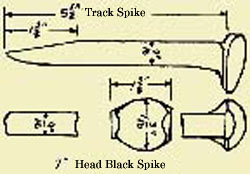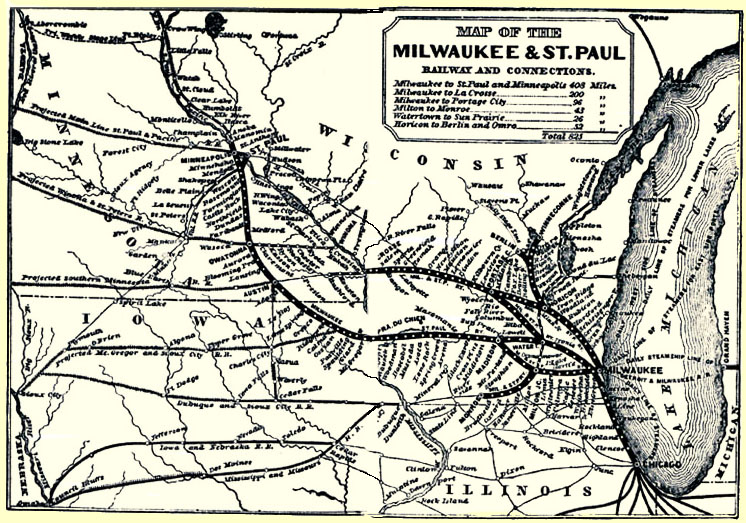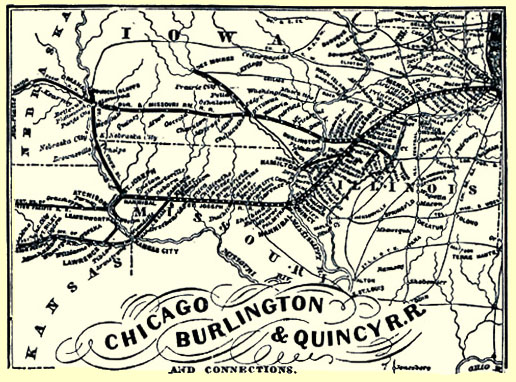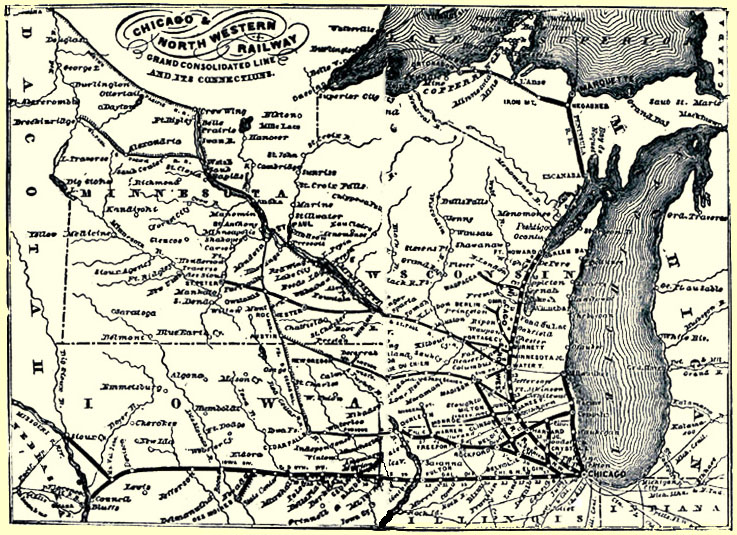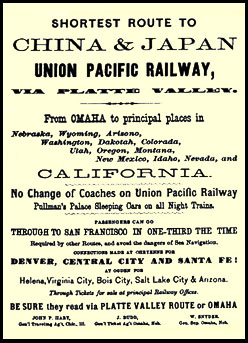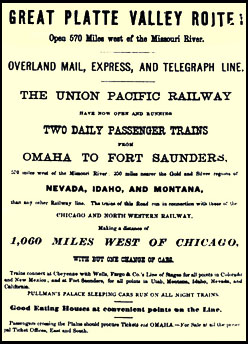|
IOWA RAILWAY GUIDE
PLANNING YOUR TRIP The great railroads of Iowa offer the modern traveler the latest in travel conveniences. The rapid completion of main trunk lines assures safe, speedy rail service to all parts of the state. Five major railroads provide connections with the great cities of Chicago, Cincinnati, Philadelphia, New York, Boston, and Washington, D.C. Continued steamboat operations on the Mississippi and the Missouri enable the Southbound traveler to reach St. Louis, Memphis, and New Orleans. The recently united Union and Central Pacific Railroads link Iowa with California, Oregon, and the vast riches of the West and even the Orient. The wise traveler will plan his trip prior to departure. Each of the railroads employs a great number of courteous, helpful agents and crews who will make your trip a pleasant and memorable event. Ticket agents stand ready to help you in planning the best route and will advise you of the best departure and arrival times. Railroad agents and conductors will direct you to the best hotels and restaurants if you need to layover or if you are not familiar with such services at your destination. You will find the train crews friendly and anxious to serve you regardless of your class of passage. It is a good idea to purchase your ticket ahead of your planned day of departure. Often the depots are crowded, with many customers lined up in front of the ticket window prior to train time. If something happens which prevents you from boarding the train on the day you had selected, tickets are good for 3 to 6 months. The railroads will be happy to refund your money. If you had reserved space on one of the new Pullman cars, the agents will gladly make new reservations. You may wish to carry your own reading material. Some of the new parlor cars contain small libraries with the latest good books. The great city newspapers are available on the trains or at depot newsstands. If you like to play cards, you will find many of your fellow travelers who also enjoy card games. FARES Passenger fares are not the same for all railroads. In recent years,
fares have averaged 2 to 3 cents per mile for adult passengers. Children
pay one‑half fare. Children under 5 years of age travel free. At this
rate, a trip between Council Bluffs and Davenport should cost no more than Some railroads charge less for a long trip than for short trips. This often happens when two competing lines serve the same terminal cities. It is a good idea to compare fares of two railroads going to your destination. A railroad is likely to charge higher fares if it is the only line in your part of Iowa. If two railroads serve an area, then they will tend to charge less. The traveler really benefits if three railroads compete between two points. DEPARTURE TIME If you plan to leave the depot while waiting for the arrival of your train, check your timepiece with the depot clock. Each railroad uses its own time system. You will also find that cities and towns use different time systems. While traveling, it is a good idea to set your timepiece by the railroad clocks. LAYOVERS Travelers often need to change trains to complete their trip. They may have to finish their trip by river steamboat or stagecoach. Hotels are located near the depot at rail junctions. The traveler will find moderate rates at these hotels. Desk clerks will awaken guests in time to board the train, stage, or steamboat. Restaurants are close to either the hotel or depot. Be sure to lock or bolt your door at the hotel. Many undesirable people are found near the depots and hotels. PASSENGER ACCOMMODATIONS Pullman or Palace Cars
A porter helps the Pullman passenger to have a more pleasant trip. He prepares the beds at night. He will order meals to be served in drawing rooms. He sets up tables so passengers can write or play cards. He handles luggage, presses clothes, shines shoes, and entertains children. Most porters deserve a generous tip as you reach the end of your trip. Pullman or Palace Car passengers can relax in the Parlor Car and can eat in the Dining Car. Parlor cars have upholstered chairs, tables for games and writing desks. Some have small libraries with recent magazines and good books. A bar is usually located at one end of the car. The passenger has a choice of fine wines and liquor. Gentlemen may smoke at the bar end of the car, Spittoons are also provided in the Parlor Car. Pullman space is reserved. Each Pullman or Palace Sleeping Car accommodates 20 to 30 passengers. If the Pullman Car is not filled, a coach passenger can obtain a berth by slipping money to the conductor and Pullman porter. Coach Cars The new coach cars have upholstered seats. The backs of the seats are hinged. This enables the passengers to adjust the seat. The new cars are heated by steam brought through pipes from the engine. Ceiling gaslights illuminate the cars. Women's and men's restrooms are located at the end of the car. Luggage racks are placed over the seats at the sides of the car. The new cars are used only on the express trains. Many trains are still equipped with the old coaches. Seats are made of slats or wicker cushions. Kerosene lamps light the cars at night. Heat is supplied by a wood‑ or coal‑burning stove at one end. In winter, it is a good idea to sit near the stove. Coach seats are not reserved. At each major stop there is a scramble for seats. If you plan an overnight trip, it is a good idea to take an old blanket or comforter. Some passengers will even carry a pillow. Sleeping in the coach seats is anything but comfortable. An overcoat can serve as a blanket substitute. Avoid opening the windows of the coaches. Smoke and cinders from the
engine come into
Immigrant Cars Immigrant passage is the cheapest available on trains. The immigrant cars have plain seats or benches. Each has toilet facilities and a stove at the end of the car. The conductor will rent the passenger a straw‑filled mattress for $1.25 to $2.50. The mattress may be placed on the seat or the floor between the seats. Passengers can cook their meals on the stove. The immigrant cars are built like box cars. Ventilation is poor‑. However, an entire family can travel for $1‑00 or $2.00. CLOTHING If you plan to ride the coach or immigrant car, do not wear your best clothes. You will find after a few hours on the train, that your clothes are rumpled arid dusty. In winter, wear your warmest clothes. Many of the older coaches are heated by a stove at one end of the car. Only those near the stove feel its warmth. However, passengers availing themselves of the new, luxurious Pullman cars should wear their best clothes. The cars are clean and devoid of dust. Pullman cars are located at the end of the train. There is little chance of smoke and cinders entering the cars, even with open windows in the summer. Overnight passengers will want to take several changes of clothes on board. MEALS
The major railroads schedule meal stops three times a day. Passengers can purchase good meals at the depot restaurants. You will want to leave the train as soon as it pulls into the station. There is quite a scramble for the meals. It is best to order the specials of the day. Most of the depot restaurants charge 25 cents for each meal. The railroads still permit passengers to take food on board with them. Many passengers pack ;1 lunch basket with sandwiches and fruit. Some will cook food on the car stoves. This is a common practice on the immigrant cars.
LUGGAGE Railroads permit the traveler to carry bags on to the Pullman, coach, or immigrant car. Trunks may be checked onto the baggage car. An additional charge is made for trunks. TRAIN CREWS Conductor The modern passenger trains are well‑manned with a full complement of crew. The most important person on the train is the conductor. He is in complete charge of the running operation of the train. He is comparable to a captain on a ship. He is responsible for starting and stopping the train, for the safety of the passengers, and for order on the train.
Engineer The engineer, of course, operates the locomotive. He starts and stops the train with a steady hand on the throttle. He determines the speed of the train according to the condition of the track ahead. He gauges the amount of steam pressure and the safety of the boiler. He supervises the work of the fireman. The fireman fuels the fire. He shovels fuel, either wood or coal, into the fire box. He is responsible for an adequate supply of fuel and water. The baggagemen ride in the baggage cars and are in charge of the passengers' baggage. They will also take care of pets and other animals that passengers are taking with them. The express trains will also have United States Post Office cars. Several postal workers will sort mail for the next stop. However, they are not classified as part of the train crew. They are too busy with their mail duties to provide services to the passengers. The first‑class sleeping cars will have porters, as will also the lounge cars. They provide a number of travel services, including the making of berths, the polishing of shoes and the pressing of clothes. The wise traveler, who plans to travel regularly on a certain line, will always tip the porter. The new dining cars will have a steward, several waiters, a chef, and two or three cooks. They, naturally, are concerned with serving fine quality meals for which the railroads are rapidly becoming famous. The great railroads of this country are proud of the courteous service given to rail passengers. However, a note of caution is in order. Travelers have experienced crewmen who proved to be disagreeable and unpleasant. Others have been suspicious that crewmen stole either money or valuables from passengers. Railroad officials want to know about such incidents. These should be reported to the proper authorities immediately. Excerpts from HARPER'S WEEKLY of May 29, 1869 "The foremost of the great projects for connecting by rail the Atlantic and Pacific coasts was realized May 10. At ten minutes past 3 o'clock P.M. at Promontory Point, Utah, the last rail was laid...
"This remarkable event was celebrated with special enthusiasm in Chicago and other Western cities. But in New York...the news was calmly received; and as on the occassion of the capture of Richmond the event was celebrated by the singing of anthems, and not by a loud uproar. A salute was fired in the City Park; peals were rung from Trinity chimes, and a religious service was held in Trinity Church. The remarks made by the Rev. Dr. Vinton were so appropriate that we quote here a portion of his address: 'This is indeed a great event of the world; it is one of the victories of peace‑a victory greater than those of war, which leave in their track desolation, devastation, misery and woe. It is a triumph of commerce‑‑a triumph indicating free trade as a future law of the nation .
. . .When we contemplate this achievement we can hardly realize its magnitude. Three thousand two hundred and eighty‑five miles of continuous railway within four degrees of latitude and fifty degrees of longtitude in the temperate zone. . . .When the ocean route was discovered around the Cape of Good Hope, it was very properly regarded as a blessing to mankind‑hence the designation by which it was known; but. . .this mighty work. . .is a still greater blessing. In the olden times, when camels. . .were the means used for transportation. . .it was found that whenever the caravans stopped there would spring up cities, and there would be the evidences of civilization. So with this great work. It will populate our vast territory, and be the great highway for the nations. . .But there is another aspect in which we view it as a blessing and. . .esteem it of still greater importance. It will preserve the union of these States. Philosophers tell us,. . .that where there are rivers which diverge in their courses, and have separate and distinct outlets (as in Europe), there the nations become diffused and the people separated and disunited. But where, on the contrary, the topography is such that the rivers all flow into one common central basin, there is necessarily a concentration of interests and of peoples, and that territory is marked out by God to be under one Government. 'By the operation of this natural law we must regard it as decreed that there shall ever be a unity of people and government in all that territory which lies between the Alleghenies and the Rocky Mountains. Beyond these lofty heights, however, we find the rivers diverging as in Europe, and following the rule that obtains in the Old World, there might be a diffusion of interests and a separation of governments in that section of the country divided from us by the Sierra Nevada and the Rocky Mountains. But this railway counteracts such natural tendency to disunion, has prevented a separation and binds the States of the Atlantic and Pacific into one nation. . .’ "
IOWA'S RAIL HISTORY All of Iowa caught the "railroad fever" during the 1850's. Iowa rail construction started at the four Mississippi River centers of Burlington, Davenport, Lyons, and Dubuque. The promoters for each of the four lines experienced the same problems. They met with alternating periods of success and failure. Raising funds proved to be the first major hurdle in building a railroad. Local citizens bought shares of stock and donated money, land, and buildings. They borrowed funds through the sale of county and town bonds. County supervisors and town councils granted special tax privileges. Some communities gave special bonuses if the railroad reached their town before a deadline date. But even with the local financial effort, it became necessary to attract Eastern and foreign capital. The sale of land grants provided another source of funds as each rail line moved westward. The railroad histories list the names of promoters and surveyors. However, much of the credit for the rail mileage in Iowa belongs to the track crews. Thousands of nameless Irish, German, and Scandinavian gandy‑dancers graded the land, placed the ties, laid the tracks, and drove the spikes. They worked in ail kinds of weather including heavy rains, snowstorms, and hot, humid summers. All stated work at daybreak. Bridge building gangs went ahead of the track crews. Surveyors and road graders followed with the track layers last. Open truck cars brought the rails to the end of the line. Teams of five men on each side unloaded the rails. A workman measured the gauge as the rails hit the ties. Then spike drivers fastened the rails. About two miles of track could be laid in a day on level ground. The crews traveled and lived in work trains made up of converted box cars. These became known as "Hell on Wheels." Many of the crew engaged in fights. Saloon‑keepers, gamblers, dance‑hall girls, and thieves followed the end of the line camps. The camp followers often became troublesome as they tried to take the workers' wages. The track crews received $1.25 per day in cash. They received their wages from a pay car sent to the end of the line. Often crooked paymasters took advantage of the immigrant workers who did not know the U. S. dollar system. Sometimes they received railroad money which could be used in railroad stores, hotels, restaurants, and saloons. On one occasion, a bankrupt railroad, the Iowa Central Air Line, paid the workers with groceries and dry goods. After that, critics called it "The Calico Road." The building of the transcontinental railroad (Union Pacific and Central Pacific) spurred the completion of main rail lines in Iowa. Each of the railroads hoped to be the connecting link between the Union Pacific and Chicago. The Cedar Rapids and Missouri had reached Boone by 1865. To the South, the Mississippi and Missouri marked time at Kellogg and the Burlington stalled at Ottumwa. In the North, the Dubuque and Pacific remained at Cedar Falls. Under the leadership of John I. Blair, the Cedar Rapids and Missouri (later Chicago and North Western) forged ahead. He started west of Boone in December, 1865. The next Spring, the line had reached Denison. On September 15, 1866, contractors started a depot in Council Bluffs. The next January (1867), crews laid the last rail in front of the new station. Council Bluffs had a complete rail route to Chicago. The Rock Island, which had taken over the Mississippi and Missouri, did not reach Council Bluffs until May 11, 1869. The Burlington finally made it there on January 3, 1870. The Dubuque and Sioux City (later on, the Illinois Central) completed its road, linking Sioux City to Chicago on July 8, 1870.
25 Important Events in Iowa's Railroad History
Explorations in Iowa History Project |

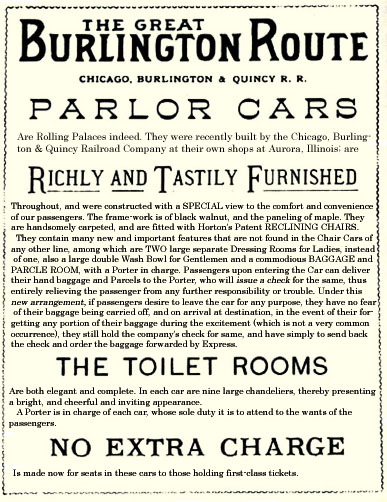 $9.48. Palace Car charges are extra.
$9.48. Palace Car charges are extra.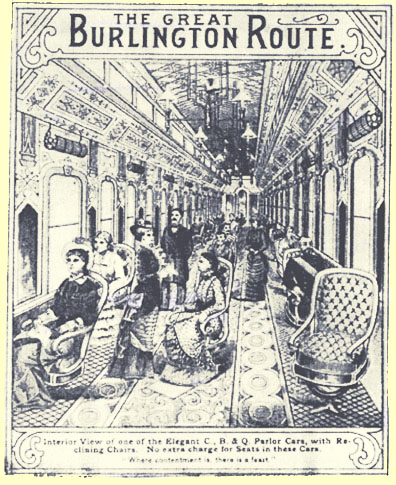 The new Pullman or Palace Cars offer the latest in travel luxury.
First‑class passengers enjoy upholstered seats, carpeted floors, and
sleeping berths at night. The cars are heated by steam brought by pipes
from the locomotive. New gaslights illuminate ceiling chandeliers.
Daytime seats are converted into beds at night. Semi‑private berth
passengers use the women's or men's restrooms at either end of the car.
Compartment and drawing room guests have their own private toilet
facilities.
The new Pullman or Palace Cars offer the latest in travel luxury.
First‑class passengers enjoy upholstered seats, carpeted floors, and
sleeping berths at night. The cars are heated by steam brought by pipes
from the locomotive. New gaslights illuminate ceiling chandeliers.
Daytime seats are converted into beds at night. Semi‑private berth
passengers use the women's or men's restrooms at either end of the car.
Compartment and drawing room guests have their own private toilet
facilities.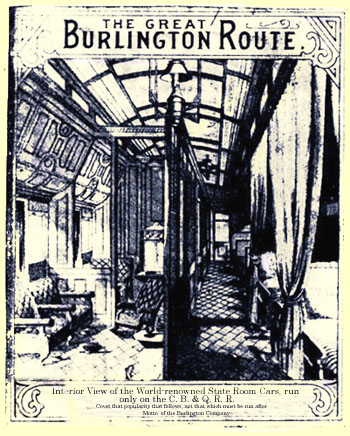 A
A 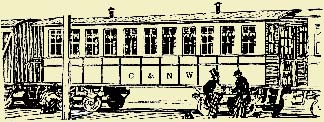
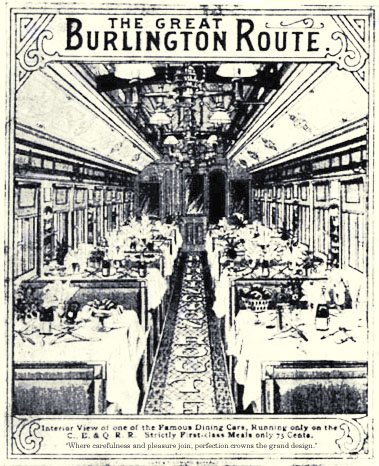 The fast express on the great trunk lines carry the new dining cars. A
sample menu is provided on page 16 of this guide, with an interior view of
one of the new dining cars on the great Burlington Railroad on page 15.
Most railroads charge 75 cents for dinners. The dining car chefs are very
proud of their meals. Most compare favorably with meals served in the
finest restaurants in Chicago and St. Louis.
The fast express on the great trunk lines carry the new dining cars. A
sample menu is provided on page 16 of this guide, with an interior view of
one of the new dining cars on the great Burlington Railroad on page 15.
Most railroads charge 75 cents for dinners. The dining car chefs are very
proud of their meals. Most compare favorably with meals served in the
finest restaurants in Chicago and St. Louis.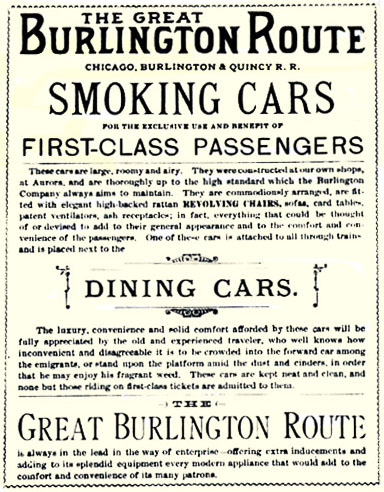
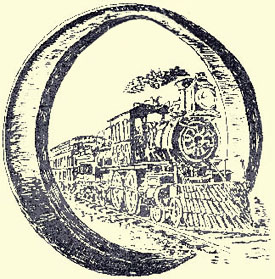 The conductor is assisted by brakemen and a flagman. The brakemen
operate the brakes on the train. Some of the older passenger cars have
separate brakes, so in case of emergencies, each car may have to be braked
individually. The flagman signals the engineer and will also signal trains
which appear to the rear of the train.
The conductor is assisted by brakemen and a flagman. The brakemen
operate the brakes on the train. Some of the older passenger cars have
separate brakes, so in case of emergencies, each car may have to be braked
individually. The flagman signals the engineer and will also signal trains
which appear to the rear of the train.